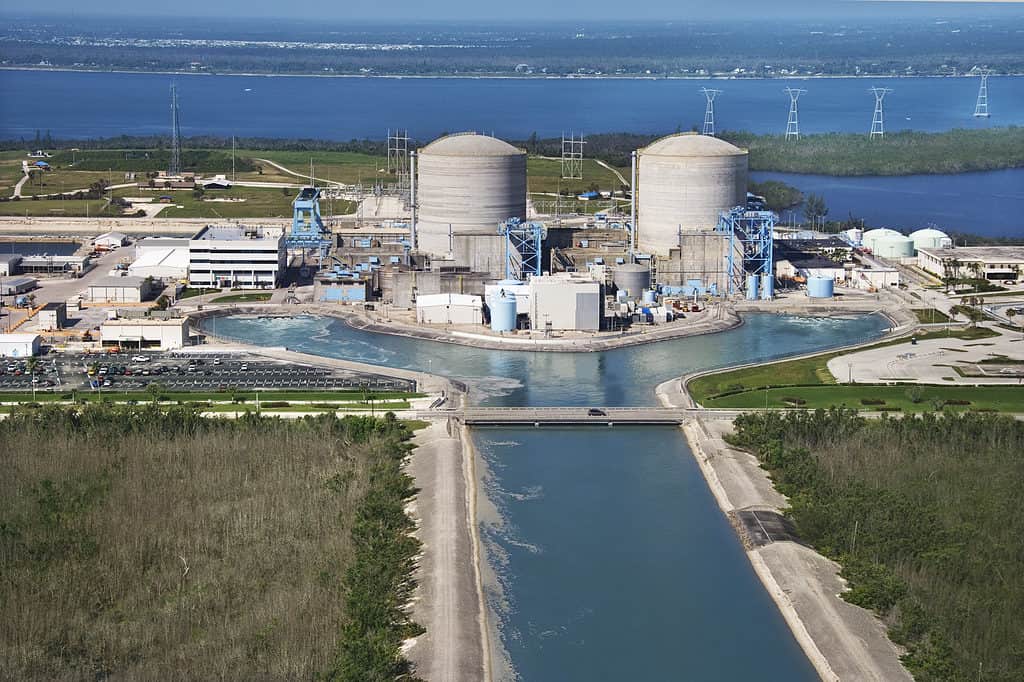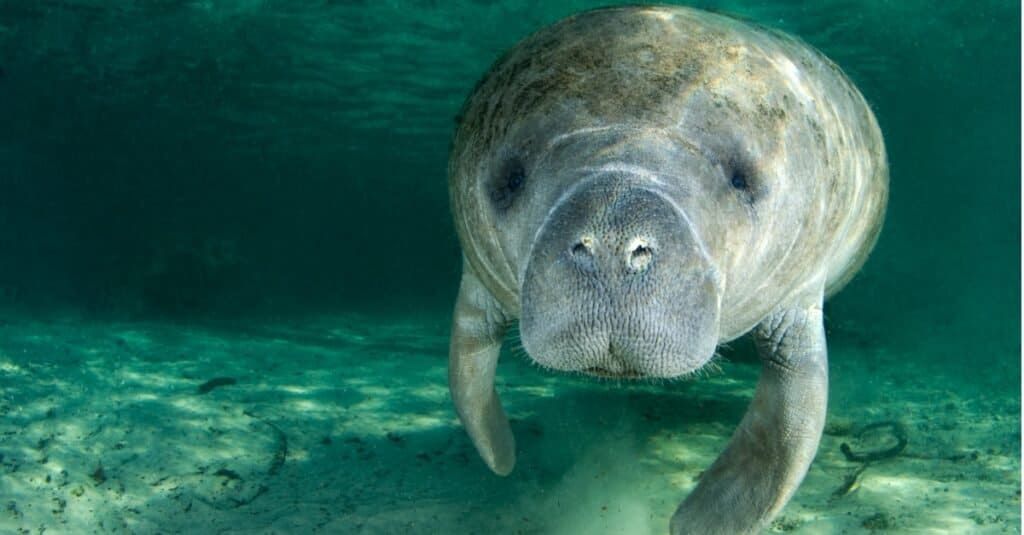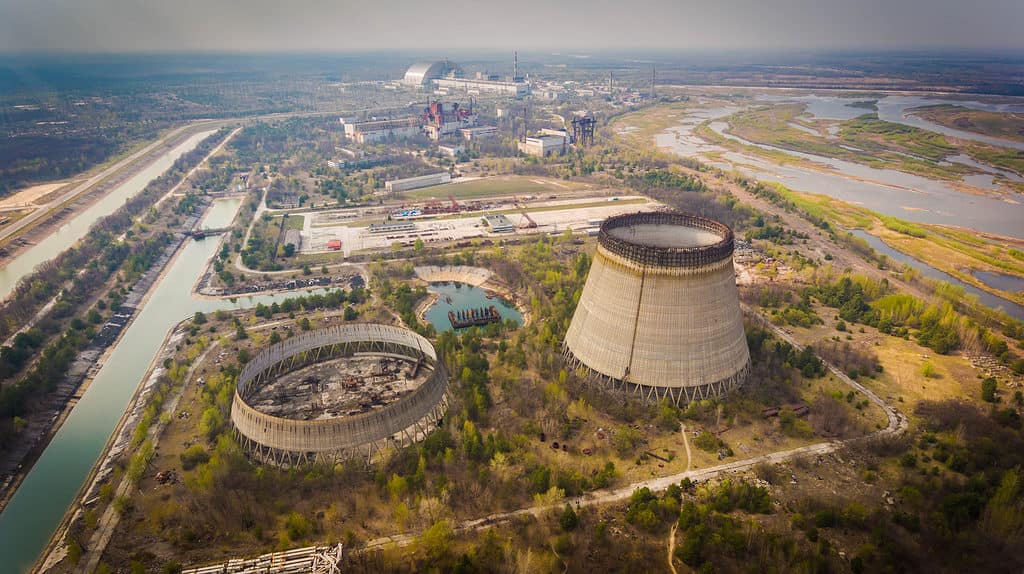Nuclear power plants are more common in the United States than one might presume. In fact, 20% of electric power in the United States comes from nuclear energy. While nuclear energy is a clean energy resource that helps to slow climate change, it also comes with many risks. Some of these dangers pose a major threat to wildlife, the environment, and human health. Discover Florida’s largest nuclear power plant and find out what kinds of wildlife live near it.

In a nuclear power plant, nuclear energy released from the splitting of uranium atoms produces heat. This heat creates steam, which turns a turbine.
©Nostal6ie/Shutterstock.com
What is Nuclear Power?
Nuclear energy occurs when energy is released from the nucleus of an atom. Atoms are comprised of protons, neutrons, and electrons. Protons and neutrons make up the core of the atom. It is from the core that nuclear energy is produced. Nuclear energy can be created through the acts of nuclear fission or nuclear fusion. Nuclear fission is the primary way that nuclear power is produced in power plants.
During nuclear fission, atoms are split into smaller nuclei. Neutrons hit the atoms to split them, and the action releases energy. Once an atom is split, its own neutrons will go on to hit other atoms, splitting them, too. Then, neutrons from the second-split atoms will hit other ones, causing a chain reaction. Energy from these splits releases heat and radiation. Heat from the reaction is harnessed to produce electricity.

Nuclear power plants do not burn fossil fuels or release greenhouse gases into the atmosphere. Therefore, many believe that nuclear power is an important strategy in slowing climate change.
©CoolKengzz/Shutterstock.com
How Does a Nuclear Power Plant Operate?
In a nuclear power plant, nuclear energy released from the splitting of uranium atoms produces heat. This heat creates steam, which turns a turbine. The turbine, then, generates electricity. Something interesting about nuclear energy is that it is considered a clean energy resource. Nuclear power plants do not burn fossil fuels or release greenhouse gases into the atmosphere. Therefore, many believe that nuclear power is an important strategy for slowing climate change.
Nuclear energy is, surprisingly, much cheaper to produce on a large scale than other forms of electricity. Furthermore, approximately one-fifth of the electricity produced in the United States derives from nuclear power. Nuclear energy is also one of the largest carbon-free producers of electricity in the United States.
The Largest Nuclear Power Plant in Florida

©iStock.com/iofoto
St. Lucie Nuclear Power Plant is the largest source of nuclear power in the state of Florida. The plant received its operating license on March 1, 1976. Since then, the plant has been providing electric power to over a million Florida residencies. The plant is located on Hutchinson Island, which is eight miles southeast of Fort Pierce, Florida. The plant is operated by Florida Power and Light Company, which is committed to providing clean energy to Floridians.
St. Lucie produces 2,000 megawatts of electricity, which is used to power numerous homes and businesses. Overall, the plant is considered safe. St. Lucie claims to be able to withstand natural disasters like hurricanes and flooding. The plant has also incorporated several safety systems to ensure that workers, wildlife, and residents remain safe.
Furthermore, St. Lucie includes various tests that operators must pass to ensure safety. These tests measure operators’ ability to react in circumstances like natural disasters or loss of power, and evaluations are held every six weeks. Frequent assessments allow St. Lucie to prioritize safety for Florida residents and for the environment. In fact, the nuclear power plant emphasizes its commitment to wildlife. St. Lucie conducts turtle walks and nesting surveys, and they collect data to aid other researchers in the protection of sea turtles.
Where is Florida’s Largest Nuclear Power Plant Located on a Map?
The largest nuclear power plant in Florida is on Hutchinson Island on the eastern shore of the state bordering the Atlantic Ocean. Hutchinson Island is eight miles southeast of Fort Pierce, Florida. The St. Lucie Nuclear Power Plant is located in the city of St. Lucie and is equipped with safety features to protect it from natural disasters like hurricanes.
Wildlife Near Florida’s Largest Nuclear Power Plant
St. Lucie boasts an impressive 180 birds and animal species that reside in their wildlife preserve. Most wildlife in and near Hutchinson Island includes birds and marine animals. Some of these aquatic animal species are manatees, dolphins, alligators, and whales. Birds near Hutchinson Island include pelicans, ospreys, great blue herons, and American white ibis.

Though St. Lucie’s main priority is sea turtles, they also protect mammal species like manatees.
©A Cotton Photo/Shutterstock.com
However, St. Lucie’s main priority is sea turtles. The plant is dedicated to sea turtle conservation, including species like the loggerhead, leatherback, green, hawksbill, and Kemp’s ridley turtles. The St. Lucie Marine Research Station works to rehabilitate and save turtles that stray from their homes and go near the power plant.
Since the opening of the power plant, researchers and conservationists associated with St. Lucie have administered more than 18,000 turtle health checks. St. Lucie encourages visitors of Hutchinson Island to be kind and gentle with sea turtles. The best course of action when coming across a sea turtle at St. Lucie is to leave it be. If a visitor finds a struggling hatchling, they should kindly redirect it to the ocean, but they shouldn’t pick it up. In addition, visitors that discover an extremely slow-moving or still sea turtle hatchling should contact Florida Fish and Wildlife Conservation Commission.
What Threats Do Nuclear Power Plants Pose to Humans and the Environment?
With over 180 animal species and a human population of over 200,000, Hutchinson Island includes a wide variety of life. However, St. Lucie Nuclear Power Plant has posed threats to life near its site. Despite regular evaluations and assessments that power plants conduct, many believe that nuclear power is dangerous. Nuclear accidents, whether intentional or unintentional, can lead to harmful effects on the environment.
Chernobyl
When accidents occur at a nuclear power plant, radiation, and radioactive material can be released into the atmosphere. Even a small amount of radiation can be fatal to both animals and humans. Furthermore, few people know how to mitigate the effects of radiation once it has leaked into the environment. Radioactive waste is difficult to handle and dispose of. In many instances following a nuclear disaster, surrounding cities are evacuated and shut down indefinitely.
For example, Chornobyl, Ukraine is a nuclear disaster that many are familiar with. Due to the poor design of a nuclear facility and poorly trained operators, the nuclear power plant at Chornobyl exploded one fateful night in 1986. The disaster led to dozens of fatalities and radioactive material released into the environment. The amount of radiation in and near Chornobyl following the accident required the evacuation of the city. Over 35 years later, Chornobyl is still deemed unsafe due to its high radiation levels.
In addition, an explosion at a nuclear power plant can result in a natural disaster. Earthquakes or aftershock sequences can occur following a nuclear disaster. While these earthquakes and aftershock sequences will not cause as much disruption as the explosion itself, their presence further adds to the risk of nuclear energy. Luckily, though, published calculations of the seismic risk of a nuclear power plant can put residents’ minds at ease. The seismic risk for St. Lucie Nuclear Power Plant is a 1 in 21,739 chance each year.

The amount of radiation in and near Chornobyl following the accident required the evacuation of the city. Over 35 years later, Chornobyl is still deemed unsafe due to its high radiation levels.
©Lux3000/Shutterstock.com
St. Lucie’s Environmental Issues
While St. Lucie Nuclear Power Plant has never experienced a disaster like that of Chornobyl, the plant has contributed to serious environmental issues. For instance, 339 sea turtles were swept into St. Lucie’s pipes in 2020. While most of the turtles were rehabilitated, six died due to the event. Furthermore, between 50 and 75 goliath grouper fish died at the hands of St. Lucie. When an assortment of jellyfish was swept into St. Lucie’s pipes, the pipes became clogged. The jellyfish stung and killed the goliath groupers, which had swum into the nuclear power plant’s intake canal.
The plant’s intake pipes harm more than marine life, though. In 2016, two scuba divers were swept into the pipes. The divers faced a serious risk of drowning, and one of them determined to sue the power plant. However, St. Lucie isn’t the only institution at fault. Conservationists have pointed the finger at the National Marine Fisheries Service. They believe that the Fisheries Service has turned a blind eye to St. Lucie’s history of harming wildlife. From the conservationist’s perspective, the Fisheries Service is as much to blame for the deaths of endangered species as St. Lucie because the institution has not held major energy producers accountable.

In 2016, two scuba divers were swept into the pipes.
©Thomas Barrat/Shutterstock.com
The photo featured at the top of this post is © Eder/Shutterstock.com
FAQs (Frequently Asked Questions)
What is the largest nuclear power plant in Florida?
The largest nuclear power plant in Florida is St. Lucie Nuclear Power Plant, which is located on Hutchinson Island.
How is nuclear energy produced?
Nuclear fission splits atoms, which releases energy in the forms of heat and radiation. Steam from the heat turns turbines, which generate electricity.
What threats do nuclear power plants pose to wildlife?
Nuclear disasters can release radiation into the atmosphere that can be fatal. In the case of St. Lucie, the plant’s intake pipes have trapped and killed several endangered species.
Thank you for reading! Have some feedback for us? Contact the AZ Animals editorial team.






